Unit 5, A Day Out
Lesson 1, Food and Drink, pages 44- -45
A. Find and circle.
Students look at the pictures and then find and circle the
words.
Answers
1. sushi
2. noodles
3. tea
4. grape juice
5. curry
6. lemonade
B. Do the puzzle.
Students look at the pictures and write the words in the
crossword puzzle.
Answers
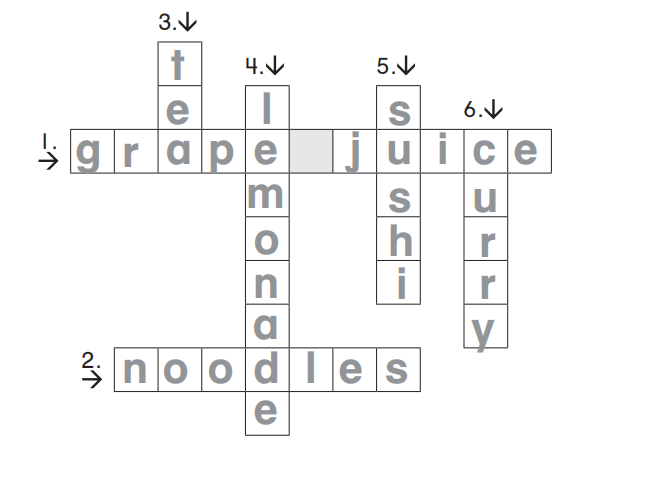
C. Write.
Students look at the pictures and complete or write the
sentences.
Answers
1. He ate sushi.
2. She drank grape juice.
3. She ate noodles.
4. He drank tea.
D. Write.
Students look at the pictures and complete or write the
questions and answers.
Answers
1. What did she eat for lunch?
She ate noodles.
2. What did he drink with lunch?
He drank lemonade.
3. What did he drink with lunch?
He drank grape juice.
4. What did she eat for lunch?
She ate curry.
Lesson 2, Things to Do, pages 46-47
A. Circle.
Students look at the pictures and circle the correct
answers.
Answers
1. take a picture
2. see a parade
3. buy clothes
4. go bowling
5. get a haircut
6. have a picnic
B. Write.
Students look at the pictures and complete the questions
and answers.
Answers
1. What did he do yesterday?
He went bowling.
2. What did she do yesterday?
She took a picture.
3. What did he do yesterday?
He saw a parade.
4. What did she do yesterday?
She bought clothes.
5. What did he do yesterday?
He got a haircut.
6. What did she do yesterday?
She had a picnic.
C. Read and circle.
Students read the charts and circle the correct answers,
completing the sentences.
Answers
1. When did she get a haircut? She got a haircut last
Wednesday.
2. When did he see a parade? He saw a parade on
Sunday afternoon.
3. When did he have a picnic? He had a picnic last
week.
4. When did she take a picture? She took a picture
yesterday. .
D. What about you? Write.
Students answer the questions, writing sentences about
themselves.
Lesson 3, Reading, pages 48- -49
A. Read and number.
Students number the sentences in the correct order.
Answers
1. I lost my skateboard.
Let's look for it together.
2. First, we worked on a project.
3. Next, we saw a parade.
4. Here you are.
Thank you. That was lucky. .
B. Write.
Students complete the sentences, using the key.
Answers
1. I lost my backpack.
2. First, we took a picture.
C. Write.
Students look at the pictures and complete or write the
questions and answers.
Answers
1. What happened?
I lost my helmet.
2. What happened?
I lost my sunglasses.
3. What happened?
I lost my gloves.
4. What happened?
I lost my watch.
D. What about you? Write.
Students answer the questions, writing sentences about
themselves.
Lesson 4, Dinosaurs, pages 50-51
A. Do the puzzle.
Students find and circle the words in the word search.
Answers
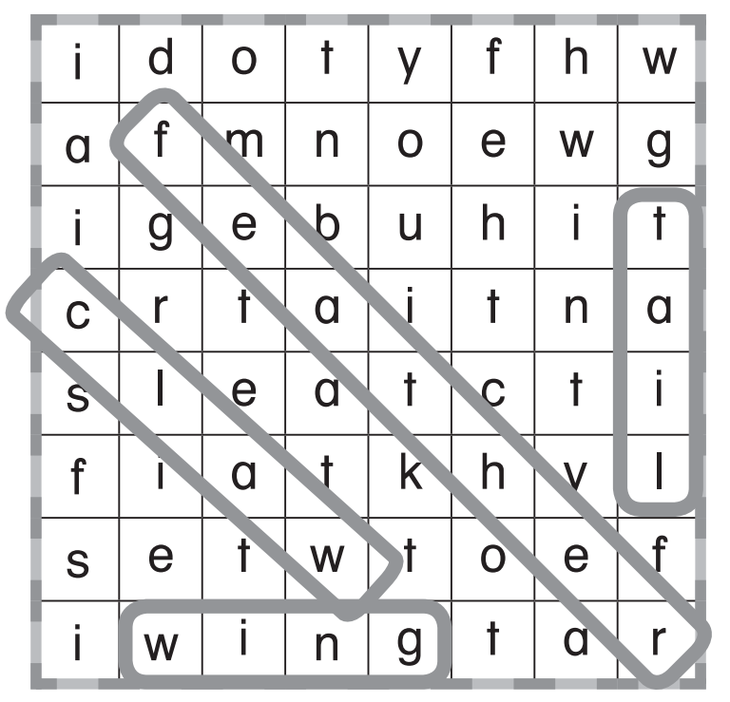
B. Match.
Students draw lines, matching the pictures to the
sentences.
Answers
1. b
2. d
3. a
4. C
C. Fill in the chart.
Students look at the pictures and fill in the chart.
Answers
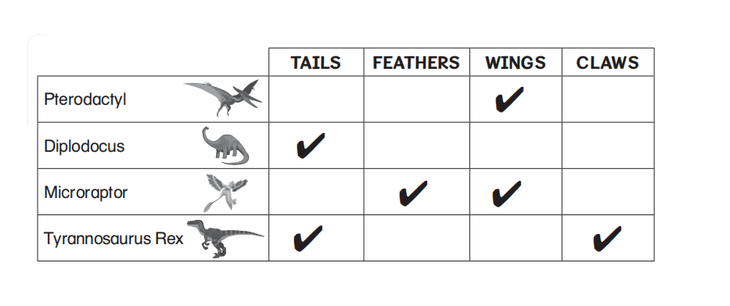
D. Draw and write.
Students draw a picture of the dinosaur that they like and
then complete the sentences.
E. Write.
Students look at the pictures and complete the sentences.
Answers
1. It has claws and a tail.
2. It has feathers and wings.
3. It has claws and a tail.
Unit 6, Being Creative
Lesson 1, The Arts, pages 52-53
A. Unscramble.
Students unscramble the letters and write the words.
Answers
1. sing songs
2. write stories
3. design clothes
4. make models
5. paint pictures
6. make movies
B. Write.
Students look at the picture and write the answers.
Answers
1. make movies
2. sing songs
3. design clothes
4. write stories
5. make models,
6. paint pictures
C. Match.
Students draw lines, matching the sentences to the
pictures. .
Answers
1. d
2.c.
3. b
4. a
D. Write.
Students look at the pictures and complete or write the
questions and answers.
Answers
1. Does she like to paint pictures?
Yes, she does.
2. Does he like to make movies?
No, he doesn't. He likes to sing songs.
3. Does she like to make models?
No, she doesn't She likes to design clothes.
4. Does he like to write stories?
Yes, he does.
Lesson 2, Making Things, pages 54- -55
A. Write.
Students look at the pictures and write the answers.
Answers
1. make jewelry
2. knit a scarf
3. bake cookies
4. cook dinner
5. play music
6. make a card
B. Circle.
Students look at the pictures and circle the correct
answers, completing the sentences.
Answers
1. She knitted a scarf for him.
2. He cooked dinner for her.
3. She baked cookies for them.
C. Write.
Students look at the picture and complete or write the
questions and answers.
Answers
1. What did he play for them?
He played music for them.
2. What did she knit for him?
She knitted a scarf for him.
3. What did he make for her?
He made jewelry for her.
4. What did she bake for them?
She baked cookies for them.
5. What did he cook for him?
He cooked dinner for him.
6. What did she make for her?
She made a card for her.
Lesson 3, Reading, pages 56- -57
A. Read and number.
Students read and then number the sentences in the
correct order.
Answers
1. Let's help him.
2. Could you carry these books for me?
3. Sure. No problem.
4. I painted this picture for you. Thanks.
B. Match.
Students draw lines, matching the pictures and sentences.
Answers
1. C
2. a
3. b
C. Write.
Students write the sentences, using the key.
Answers
1. Let's help her.
2. Can you open the window for me?
3. Sure. No, problem.
4. Thank you.
D. What about you? Write.
Students answer the questions, writing sentences about
themselves.
Lesson 4, Types of Art, pages 58- 59
A. Write.
Students look at the pictures and write the answers.
Answers
1. mosaic
2. photograph
3. sculpture
4. painting
B. Match.
Students draw lines, matching the pictures to the
sentences.
Answers
1. d
2. a
3. C
4. b
C. Write.
Students look at the pictures and complete the sentences.
Answers
1. This is a mosaic of a girl. She's kicking a ball.
2. This is a photograph of a boy. He's drinking milk
3. This is a sculpture of a girl. She's knitting.
4. This is a painting of a boy. He's getting a haircut.
D. What about you? Write.
Students answer the questions, writing sentences about
themselves.
Check Up 3, pages 60- -62
A. Match.
Students write the letter of the picture that matches the
word or phrase.
Answers
1. d
2. f
3. b
4. C
5. a
6. e
B. Read, write, and number.
Students read and complete the sentences, then number
the pictures.
Answers
1. This is a mosaic of a girl. [4th picture]
2. He likes to paint pictures in his free time.
[1st picture ]
3. Some dinosaurs had claws. [2nd picture]
4. What did he drink with lunch? [3rd picture]
C. Read, circle, and write.
Students look at the pictures, circle the correct answer,
and write sentences.
Answers
1. What did she do yesterday?
She had a picnic.
2. Does he like to make movies?
Yes, he does.
3. What did he make for her?
He made a necklace for her.
4. What did she eat for lunch?
She ate noodles.
D. Look at the pictures. Write.
Students look at the pictures and write to complete the
dialogue.
Answers
1. What happened?
I lost my ball.
2. Could you walk the dog for me?
Sure. No problem.
E. What do you like to do in your free time? Write.
Students answer the question, writing a sentence about
themselves.
F. Complete the sentences and do the puzzle.
Students use the key to fill in the crossword puzzle and
complete the sentences.
Answers
1. This is a sculpture.
2. He ate noodles for lunch.
3. He saw a parade yesterday.
4. She likes to sing songs.
5. He went bowling yesterday.
6. Some dinosaurs had tails.
7. He cooked dinner for them.
8. This is a mosaic of a woman.
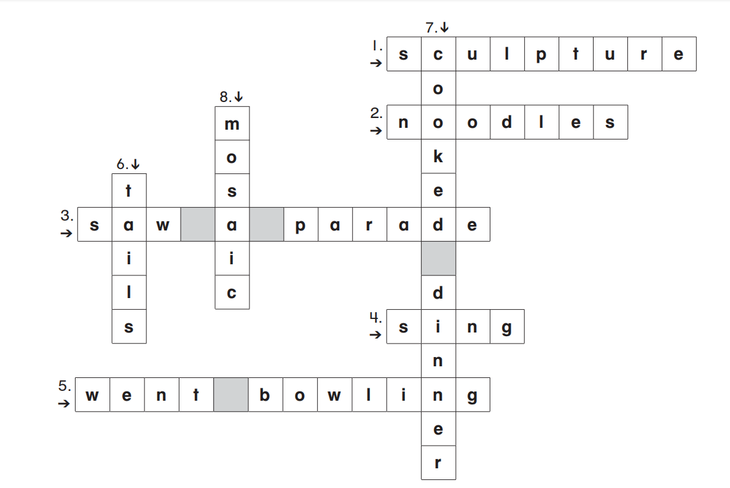
Skills3, page 63
A. Read and circle.
Students read the passage and circle the correct answers.
Answers
1. True
2. False
3. False
4. False .
B. What about you? Write.
Students answer the questions, writing sentences about
themselves.
Unit 7, Things to Be
Lesson 1, Careers, pages 64-65
A. Circle.
Students look at the pictures and circle the correct
answers.
Answers
1. artist
2. scientist
3. game designer
4. actor
5. musician
6. journalist
B. Write.
Students look at the pictures and write the answers.
Answers
1. actor
2. journalist
3. game designer
4. musician
5. artist
6. scientist
C. Match.
Students draw lines, matching the pictures to the
sentences.
Answers
1.b
2. C
3. d
4. a
D. Write.
Students look at the pictures and complete or write the
sentences.
Answers
1. What does he want to be when he grows up?
He wants to be a journalist.
2. What does she want to be when she grows up?
She wants to be a scientist.
3. What does he want to be when he grows up?
He wants to be a game designer.
4. What does she want to be when she grows up?
She wants to be an artist.
Lesson 2, The Future, pages 66-67
A. Write.
Students look at the pictures and write the answers.
Answers
1.fly a helicopter
2. explore the jungle
3. drive a race car
4. go to space
5. travel the world
6. work with animals
B. Write.
Students look at the pictures and complete or write the
questions and answers.
Answers
1. What do you want to do when you're older?
I want to work with animals.
2. What do you want to do when you're older?
I want to explore the jungle.
3. What do you want to do when you're older?
I want to travel the world.
C. Circle.
Students circle the correct words, completing the sentences.
Answers
1. What does she want to do when she's older?
She wants to go to space.
2. What does he want to do when he's older?
He wants to drive a race car.
3. What does she want to do when she's older?
She wants to fly a helicopter.
D. What do you want to do when you're older? Write.
Students answer the question, writing about themselves.
Lesson 3, Reading, pages 68-69
A. Read and number.
Students read and then number the sentences in the
correct order.
Answers
1. Let's go see the animals!
Wait a minute.
2. What does that sign mean?
It means you can't run here.
3. What does that sign mean?
It means you can't feed the animals.
4. I want to work with animals when I'm older.
B. Unscramble.
Students unscramble the letters and write the sentences.
Answers
1. What does that sign mean?
2. It means you can't take pictures here.
3. I want to be a journalist when I'm older.
C. Write.
Students look at the pictures and complete or write the
sentences.
Answers
1. What does that sign mean?
It means you can't climb trees here.
2. What does that sign mean?
It means you can't skateboard here.
3. What does that sign mean?
It means you can't use a phone here.
4. What does that sign mean?
It means you can't play soccer here.
D. Draw a sign. What does it mean?
Students draw a picture of a sign and then explain what
that sign means.
Lesson 4, In Space, pages 70-71
A. Write.
Students look at the pictures and write the answers.
Answers
1. space shuttle
2. space suit
3. space station
4. Earth
B. Read and circle.
Students look at the pictures and circle the correct
answers, completing the sentences.
Answers
1. Astronauts have to work on the computer.
2. Astronauts have to stay strong.
3. Astronauts have to leave the space station.
4. Astronauts don't have to be scientists to work in the
space station.
C. Write.
Students look at the pictures and complete or write the
sentences.
Answers
1. Astronauts have to be friendly in the space station.
2. Astronauts have to take the space shuttle to get to
the space station.
3. Astronauts have to wear space suits outside the
space station.
4. Astronauts have to be careful in the space station.
D. What do you have to do at school? Write.
Students answer the question, writing about themselves.
Unit 8, On Vacation
Lesson 1, Activities, pages 72- -73.
A. Match.
Students write letters to match the pictures to the words.
Answers
1. c
2. e
3. f
4.b
5. d
6. a
B. Unscramble.
Students unscramble the letters and write the answers.
Answers
1. see a show
2. stay in a hotel
3.go on a bus tour
4. swim in the ocean
5. take a boat ride .
6. ride a horse
C. Write.
Students look at the pictures and complete or write the
questions and answers.
Answers
1. What's she going to do on vacation?
She's going to take a boat ride.
2. What's he going to do on vacation?
He's going to stay in a hotel.
3. What's she going to do on vacation?
She's going to go on a bus tour.
D. Write.
Students look at the chart and answer the questions.
Answers
1. He's going to ride a horse next Monday.
2. He's going to swim in the ocean next weekend.
3. He's going to see a show tomorrow.
Lesson 2, Things for a Trip, pages 74- -75
A. Do the puzzle.
Students look at the pictures and write the words in the
crossword puzzle.
Answers
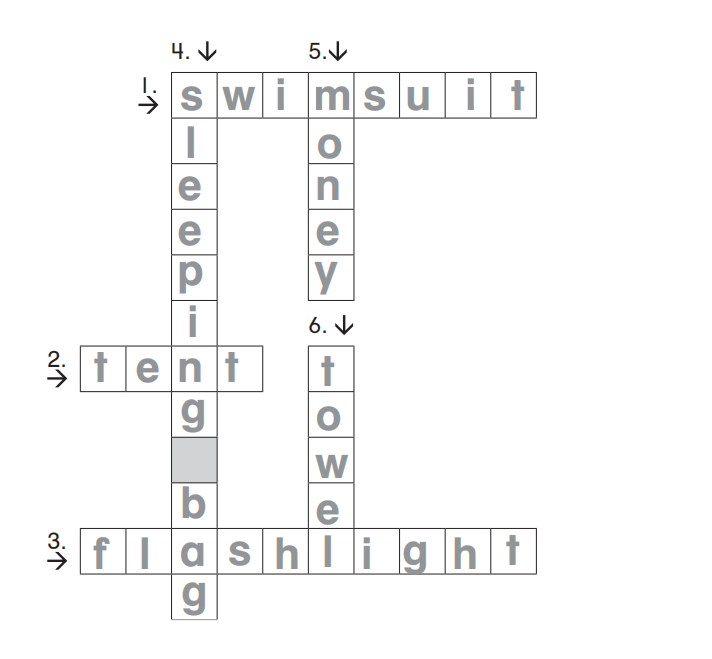
B. Match.
Students write letters to match the pictures to the
sentences.
Answers
1.b
2. d
3. a
4. e
5.c
C. Look at the chart. Write.
Students look at the chart and then complete or write the
questions and answers.
Answers
1. Are they going to take towels with them?
Yes, they are.
Are they going to take money with them?
No, they aren't.
2. Are they going to take swimsuits with them?
Yes, they are.
Are they going to take tents with them?
No, they aren't.
3. Are they going to take flashlights with them?
Yes, they are.
Are they going to take sleeping bags with them?
No, they aren't.
Lesson 3, Reading, pages 76-77
A. Match.
Students draw lines, matching the pictures to the
sentences.
Answers
1. d
2. C
3. a
4. b
B. Unscramble.
Students unscramble the letters and write the answers.
Answers
1. I'm going to ride a camel.
2. See you next month.
3. I'm going to miss you.
4. Have a great time.
C. Write.
Students look at the pictures and complete or write the
questions and answers.
Answers
1. What are you going to do tomorrow?
I'm going to go on a bus tour.
2. What are you going to do next weekend?
I'm going to stay in a hotel.
3. What are you going to do next week?
I'm going to ride a horse.
D. What about you? Write.
Students answer the questions, writing sentences about
themselves.
Lesson 4, Transportation, pages 78- - 79
A. Write.
Students look at the pictures and write the answers.
Answers
1. subway
2. taxi
3. gondola
4. ferry
B. Circle.
Students look at the pictures and circle the correct
answers.
Answers
1. She's going to take a taxi.
2. They re going to take a ferry.
3. He's going to take the subway.
4. They re going to take a gondola.
C. Write.
Students look at the pictures and complete or write the
questions and answers.
Answers
1. How's he going to get to the restaurant?
He's going to take a gondola.
2. How's she going to get to the museum?
She's going to take the subway.
3. How are they going to get to the hotel?
They re going to take a ferry.
4. How are they going to get to the park?
They're going to take a taxi.
Check Up 4, pages 80- -82
A. Unscramble and check.
Students look at the pictures and unscramble the words,
then check the relevant words.
Answers
1. towel swimsuit √ flashlight
2. space suit Earth √ space station
3.√ fly drive explore
4. ferry taxi √ subway
5. actors √musician artist
6.√ ride see swim
B. Read, circle, and match.
Students read the sentences, circle the correct word or
phrase, and match the sentences with the pictures.
Answers
1. She wants to go to space. b
2. Astronauts have to stay strong. a
3. He's going to stay in a hotel. d
4. She wants to work with animals. c :
C. Look at the pictures. Unscramble the questions.
Students look at the pictures and unscramble the words.
Answers
1. What's she going to do on vacation?
2. What does he want to be when he grows up?
3. What's he going to take with him?
4. How are they going to get to the hotel?
D. Look at the pictures. Write.
Students look at the pictures and write to complete the
dialogue.
Answers
1. What does that sign mean?
It means you can't use a cell phone here.
2. Bye. Have a great time!
Thank you. See you next month.
E. What are you going to do on vacation? Write.
Students answer the question, writing a sentence about
themselves.
F. Do the puzzle.
Students use the key to fill in the crossword puzzle.
Answers
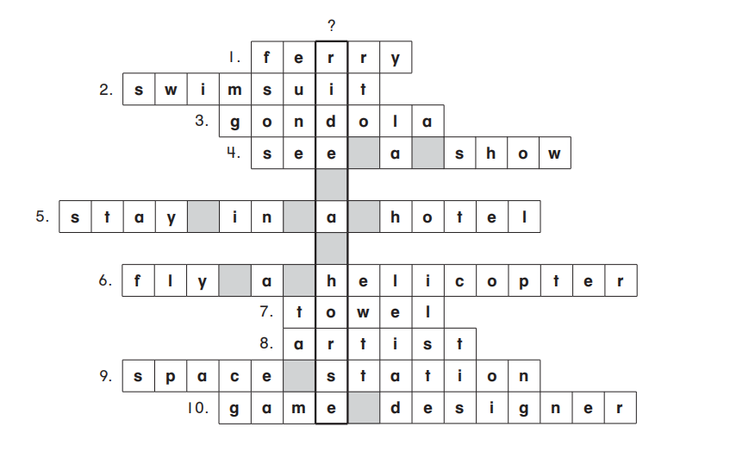
G. Look at F . Write and draw.
Students use the answers in exercise F to find the missing
words, then draw a picture.
Answer
I'm going to ride a horse on vacation!
Skills 4, page 83
A. Read and circle.
Students read the passage and circle the correct answers.
Answers
1. False
2. True
3. False .
4. True :
B. What about you? Look at A. Write.
Students look at exercise A as an example and complete the
sentences, writing about themselves.
